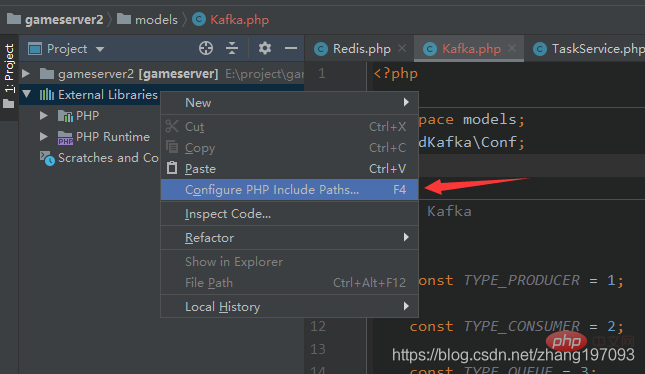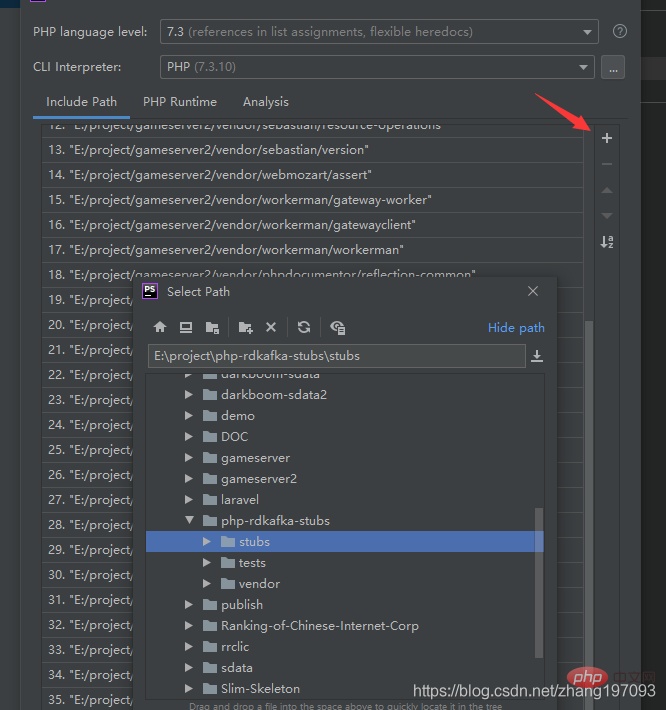Teach you how to quickly install php+kafka
We have learned so much about PHP. Today I will teach you how to quickly install PHP kafka. If you don’t know how to do it, then follow this article and continue learning
1. Install java and set relevant environment variables
> wget https://download.java.net/openjdk/jdk7u75/ri/openjdk-7u75-b13-linux-x64-18_dec_2014.tar.gz > tar zxvf openjdk-7u75-b13-linux-x64-18_dec_2014.tar.gz > mv java-se-7u75-ri/ /opt/ > export JAVA_HOME=/opt/java-se-7u75-ri > export PATH=$PATH:$JAVA_HOME/bin:$JAVA_HOME/jre/bin > export CLASSPATH=.:$JAVA_HOME/lib:$JAVA_HOME/lib/tools.jar #验证安装 > java -verison openjdk version "1.7.0_75" OpenJDK Runtime Environment (build 1.7.0_75-b13) OpenJDK 64-Bit Server VM (build 24.75-b04, mixed mode)
2. Install kafka, here we take version 0.10.2 as an example
> wget http://archive.apache.org/dist/kafka/0.10.2.0/kafka_2.11-0.10.2.0.tgz > tar zxvf kafka_2.11-0.10.2.0.tgz > mv kafka_2.11-0.10.2.0/ /opt/kafka > cd /opt/kafka #启动zookeeper > bin/zookeeper-server-start.sh config/zookeeper.properties [2013-04-22 15:01:37,495] INFO Reading configuration from: config/zookeeper.properties (org.apache.zookeeper.server.quorum.QuorumPeerConfig) ... #启动kafka > bin/kafka-server-start.sh config/server.properties [2013-04-22 15:01:47,028] INFO Verifying properties (kafka.utils.VerifiableProperties) [2013-04-22 15:01:47,051] INFO Property socket.send.buffer.bytes is overridden to 1048576 (kafka.utils.VerifiableProperties) ... #尝试创建一个topic > bin/kafka-topics.sh --create --zookeeper localhost:2181 --replication-factor 1 --partitions 1 --topic test > bin/kafka-topics.sh --list --zookeeper localhost:2181 test #生产者写入消息 > bin/kafka-console-producer.sh --broker-list localhost:9092 --topic test This is a message This is another message #消费者消费消息 > bin/kafka-console-consumer.sh --bootstrap-server localhost:9092 --topic test --from-beginning This is a message This is another message
3. Install the C operation library of kafka
> wget https://github.com/edenhill/librdkafka/archive/v1.3.0.tar.gz > tar zxvf v1.3.0.tar.gz > cd librdkafka-1.3.0 > ./configure > make && make install
4. Install the kafka extension of php. Here select the php-rdkafka extension https://github.com/arnaud-lb/php-rdkafka
> wget https://github.com/arnaud-lb/php-rdkafka/archive/4.0.2.tar.gz > tar 4.0.2.tar.gz > cd php-rdkafka-4.0.2 > /opt/php7/bin/phpize > ./configure --with-php-config=/opt/php7/bin/php-config > make && make install
Modify php.ini and add extension=rdkafka.so
5. Install the IDE code prompt file of rdkafka
> composer create-project kwn/php-rdkafka-stubs php-rdkafka-stubs
Take phpstrom as an example, in the External of your project Right-click on Libraries, select Configure PHP Include Paths, and add the path just now.


6. Write php test code
producer:
<?php
$conf = new RdKafka\Conf();
$conf->set('log_level', LOG_ERR);
$conf->set('debug', 'admin');
$conf->set('metadata.broker.list', 'localhost:9092');
//If you need to produce exactly once and want to keep the original produce order, uncomment the line below
//$conf->set('enable.idempotence', 'true');
$producer = new RdKafka\Producer($conf);
$topic = $producer->newTopic("test2");
for ($i = 0; $i < 10; $i++) {
$topic->produce(RD_KAFKA_PARTITION_UA, 0, "Message $i");
$producer->poll(0);
}
for ($flushRetries = 0; $flushRetries < 10; $flushRetries++) {
$result = $producer->flush(10000);
if (RD_KAFKA_RESP_ERR_NO_ERROR === $result) {
break;
}
}
if (RD_KAFKA_RESP_ERR_NO_ERROR !== $result) {
throw new \RuntimeException('Was unable to flush, messages might be lost!');
}low-level consumer:
<?php
$conf = new RdKafka\Conf();
$conf->set('log_level', LOG_ERR);
$conf->set('debug', 'admin');
// Set the group id. This is required when storing offsets on the broker
$conf->set('group.id', 'myConsumerGroup');
$rk = new RdKafka\Consumer($conf);
$rk->addBrokers("127.0.0.1");
$topicConf = new RdKafka\TopicConf();
$topicConf->set('auto.commit.interval.ms', 100);
// Set the offset store method to 'file'
$topicConf->set('offset.store.method', 'broker');
// Alternatively, set the offset store method to 'none'
// $topicConf->set('offset.store.method', 'none');
// Set where to start consuming messages when there is no initial offset in
// offset store or the desired offset is out of range.
// 'smallest': start from the beginning
$topicConf->set('auto.offset.reset', 'smallest');
$topic = $rk->newTopic("test2", $topicConf);
// Start consuming partition 0
$topic->consumeStart(0, RD_KAFKA_OFFSET_STORED);
while (true) {
$message = $topic->consume(0, 10000);
switch ($message->err) {
case RD_KAFKA_RESP_ERR_NO_ERROR:
print_r($message);
break;
case RD_KAFKA_RESP_ERR__PARTITION_EOF:
echo "No more messages; will wait for more\n";
break;
case RD_KAFKA_RESP_ERR__TIMED_OUT:
echo "Timed out\n";
break;
default:
throw new \Exception($message->errstr(), $message->err);
break;
}
}high-level consumer:
<?php
$conf = new RdKafka\Conf();
// Set a rebalance callback to log partition assignments (optional)
$conf->setRebalanceCb(function (RdKafka\KafkaConsumer $kafka, $err, array $partitions = null) {
switch ($err) {
case RD_KAFKA_RESP_ERR__ASSIGN_PARTITIONS:
echo "Assign: ";
var_dump($partitions);
$kafka->assign($partitions);
break;
case RD_KAFKA_RESP_ERR__REVOKE_PARTITIONS:
echo "Revoke: ";
var_dump($partitions);
$kafka->assign(NULL);
break;
default:
throw new \Exception($err);
}
});
// Configure the group.id. All consumer with the same group.id will consume
// different partitions.
$conf->set('group.id', 'myConsumerGroup');
// Initial list of Kafka brokers
$conf->set('metadata.broker.list', '127.0.0.1');
// Set where to start consuming messages when there is no initial offset in
// offset store or the desired offset is out of range.
// 'smallest': start from the beginning
$conf->set('auto.offset.reset', 'smallest');
$consumer = new RdKafka\KafkaConsumer($conf);
// Subscribe to topic 'test2'
$consumer->subscribe(['test2']);
echo "Waiting for partition assignment... (make take some time when\n";
echo "quickly re-joining the group after leaving it.)\n";
while (true) {
$message = $consumer->consume(1000);
switch ($message->err) {
case RD_KAFKA_RESP_ERR_NO_ERROR:
print_r($message);
break;
case RD_KAFKA_RESP_ERR__PARTITION_EOF:
echo "No more messages; will wait for more\n";
break;
case RD_KAFKA_RESP_ERR__TIMED_OUT:
echo "Timed out\n";
break;
default:
throw new \Exception($message->errstr(), $message->err);
break;
}
sleep(2);
}Recommended study: "PHP Video Tutorial 》
The above is the detailed content of Teach you how to quickly install php+kafka. For more information, please follow other related articles on the PHP Chinese website!

Hot AI Tools

Undresser.AI Undress
AI-powered app for creating realistic nude photos

AI Clothes Remover
Online AI tool for removing clothes from photos.

Undress AI Tool
Undress images for free

Clothoff.io
AI clothes remover

Video Face Swap
Swap faces in any video effortlessly with our completely free AI face swap tool!

Hot Article

Hot Tools

Notepad++7.3.1
Easy-to-use and free code editor

SublimeText3 Chinese version
Chinese version, very easy to use

Zend Studio 13.0.1
Powerful PHP integrated development environment

Dreamweaver CS6
Visual web development tools

SublimeText3 Mac version
God-level code editing software (SublimeText3)

Hot Topics
 1666
1666
 14
14
 1425
1425
 52
52
 1325
1325
 25
25
 1272
1272
 29
29
 1252
1252
 24
24
 PHP and Python: Comparing Two Popular Programming Languages
Apr 14, 2025 am 12:13 AM
PHP and Python: Comparing Two Popular Programming Languages
Apr 14, 2025 am 12:13 AM
PHP and Python each have their own advantages, and choose according to project requirements. 1.PHP is suitable for web development, especially for rapid development and maintenance of websites. 2. Python is suitable for data science, machine learning and artificial intelligence, with concise syntax and suitable for beginners.
 PHP in Action: Real-World Examples and Applications
Apr 14, 2025 am 12:19 AM
PHP in Action: Real-World Examples and Applications
Apr 14, 2025 am 12:19 AM
PHP is widely used in e-commerce, content management systems and API development. 1) E-commerce: used for shopping cart function and payment processing. 2) Content management system: used for dynamic content generation and user management. 3) API development: used for RESTful API development and API security. Through performance optimization and best practices, the efficiency and maintainability of PHP applications are improved.
 PHP: A Key Language for Web Development
Apr 13, 2025 am 12:08 AM
PHP: A Key Language for Web Development
Apr 13, 2025 am 12:08 AM
PHP is a scripting language widely used on the server side, especially suitable for web development. 1.PHP can embed HTML, process HTTP requests and responses, and supports a variety of databases. 2.PHP is used to generate dynamic web content, process form data, access databases, etc., with strong community support and open source resources. 3. PHP is an interpreted language, and the execution process includes lexical analysis, grammatical analysis, compilation and execution. 4.PHP can be combined with MySQL for advanced applications such as user registration systems. 5. When debugging PHP, you can use functions such as error_reporting() and var_dump(). 6. Optimize PHP code to use caching mechanisms, optimize database queries and use built-in functions. 7
 PHP vs. Python: Understanding the Differences
Apr 11, 2025 am 12:15 AM
PHP vs. Python: Understanding the Differences
Apr 11, 2025 am 12:15 AM
PHP and Python each have their own advantages, and the choice should be based on project requirements. 1.PHP is suitable for web development, with simple syntax and high execution efficiency. 2. Python is suitable for data science and machine learning, with concise syntax and rich libraries.
 The Enduring Relevance of PHP: Is It Still Alive?
Apr 14, 2025 am 12:12 AM
The Enduring Relevance of PHP: Is It Still Alive?
Apr 14, 2025 am 12:12 AM
PHP is still dynamic and still occupies an important position in the field of modern programming. 1) PHP's simplicity and powerful community support make it widely used in web development; 2) Its flexibility and stability make it outstanding in handling web forms, database operations and file processing; 3) PHP is constantly evolving and optimizing, suitable for beginners and experienced developers.
 PHP vs. Other Languages: A Comparison
Apr 13, 2025 am 12:19 AM
PHP vs. Other Languages: A Comparison
Apr 13, 2025 am 12:19 AM
PHP is suitable for web development, especially in rapid development and processing dynamic content, but is not good at data science and enterprise-level applications. Compared with Python, PHP has more advantages in web development, but is not as good as Python in the field of data science; compared with Java, PHP performs worse in enterprise-level applications, but is more flexible in web development; compared with JavaScript, PHP is more concise in back-end development, but is not as good as JavaScript in front-end development.
 PHP and Python: Code Examples and Comparison
Apr 15, 2025 am 12:07 AM
PHP and Python: Code Examples and Comparison
Apr 15, 2025 am 12:07 AM
PHP and Python have their own advantages and disadvantages, and the choice depends on project needs and personal preferences. 1.PHP is suitable for rapid development and maintenance of large-scale web applications. 2. Python dominates the field of data science and machine learning.
 PHP and Python: Different Paradigms Explained
Apr 18, 2025 am 12:26 AM
PHP and Python: Different Paradigms Explained
Apr 18, 2025 am 12:26 AM
PHP is mainly procedural programming, but also supports object-oriented programming (OOP); Python supports a variety of paradigms, including OOP, functional and procedural programming. PHP is suitable for web development, and Python is suitable for a variety of applications such as data analysis and machine learning.




